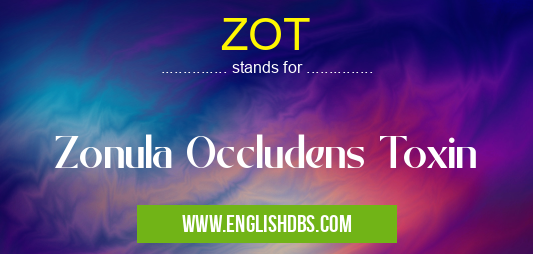What does ZOT mean in UNCLASSIFIED
ZOT stands for Zonula Occludens Toxin. It is a toxin produced by the bacterium Vibrio cholerae, which causes cholera. ZOT is responsible for the severe diarrhea that is characteristic of cholera.

ZOT meaning in Unclassified in Miscellaneous
ZOT mostly used in an acronym Unclassified in Category Miscellaneous that means Zonula Occludens Toxin
Shorthand: ZOT,
Full Form: Zonula Occludens Toxin
For more information of "Zonula Occludens Toxin", see the section below.
Properties and Mechanism of Action
- ZOT is a small, heat-stable protein that binds to the claudins, which are proteins that form the tight junctions between intestinal epithelial cells.
- Binding of ZOT to claudins causes a disruption of the tight junctions, leading to an increase in intestinal permeability.
- This increased permeability allows water and electrolytes to leak out of the intestinal lumen, resulting in severe diarrhea.
Transmission and Symptoms of ZOT-Mediated Cholera
- ZOT-mediated cholera is transmitted through the ingestion of contaminated food or water.
- Symptoms typically develop within 12-24 hours of exposure and include:
- Profuse, watery diarrhea
- Vomiting
- Dehydration
- Muscle cramps
- If left untreated, cholera can lead to severe dehydration, electrolyte imbalance, and even death.
Treatment and Prevention
- Treatment for cholera involves rapid rehydration with oral or intravenous fluids to replace lost fluids and electrolytes.
- Antibiotics can also be used to kill the V. cholerae bacteria.
- Prevention of cholera involves:
- Access to clean water and sanitation
- Vaccination
- Education about safe food handling practices
Essential Questions and Answers on Zonula Occludens Toxin in "MISCELLANEOUS»UNFILED"
What is Zonula Occludens Toxin (ZOT)?
ZOT is a potent bacterial toxin that disrupts the tight junctions between epithelial cells, leading to increased permeability and barrier dysfunction. It is produced by various pathogenic bacteria, including Vibrio cholerae and Escherichia coli.
How does ZOT work?
ZOT binds to specific receptors on the surface of epithelial cells, causing a cascade of events that ultimately leads to the disassembly of tight junctions. This breakdown allows ions, water, and pathogens to pass through the epithelial barrier, leading to dehydration and inflammation.
What are the clinical effects of ZOT?
ZOT plays a crucial role in the pathogenesis of cholera, a severe diarrheal disease. The toxin disrupts the tight junctions in the intestinal epithelium, resulting in the loss of fluids and electrolytes, leading to dehydration and potentially life-threatening complications.
How is ZOT treated?
Treatment for ZOT-mediated illnesses, such as cholera, focuses on rehydration and electrolyte replacement. Antibiotics may also be used to eliminate the bacteria producing the toxin.
Can ZOT be used for therapeutic purposes?
Research is exploring the potential therapeutic applications of ZOT. By disrupting tight junctions, ZOT could enhance drug delivery across epithelial barriers and improve the treatment of various diseases.
Final Words: ZOT is a potent toxin that plays a crucial role in the pathogenesis of cholera. Understanding its mechanism of action is essential for developing effective treatments and preventive measures to combat this deadly disease.
ZOT also stands for: |
|
| All stands for ZOT |
